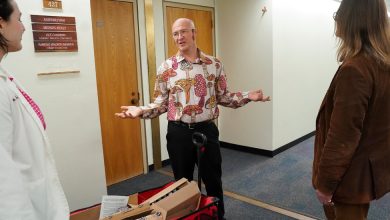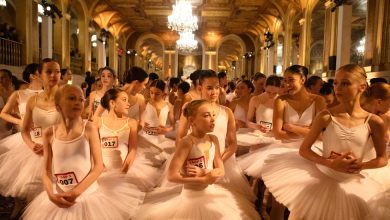Overlooked No More: Ady Fidelin, Black Model ‘Hidden in Plain Sight’

This article is part of Overlooked, a series of obituaries about remarkable people whose deaths, beginning in 1851, went unreported in The Times.
In a series of photographs from the summer of 1937, a group of close friends are captured enjoying a laid-back vacation in the south of France, swimming, relaxing and having fun. Most of the holidaymakers were artists, among themMan Ray, Picasso and Dora Maar (who was also Picasso’s lover at the time).
Part of that circle was a vivacious woman whose name isn’t well known but who was a vital participant nonetheless: Ady Fidelin, who also went by Adrienne. In the photos, she stands out for her beauty and also because, unlike her fellow holidaymakers, she was Black.
Fidelin, a dancer, model and occasional actress, was Man Ray’s girlfriend and frequently posed for him as well. In hundreds of his photographs she is dancing or seated, occasionally holding props, like hula hoops and hats. Often she is nude or topless. In every image her exuberance shines through.
Fidelin posed for Man Ray’s own circle of artists, too, including the photographer Lee Miller, a former girlfriend of Man Ray’s; Roland Penrose, who would later marry Miller; the British Surrealist artist Eileen Agar; and the artist Alfred Otto Wolfgang Schulze, who went by Wols.
“She was a muse not only to Man Ray,” Andrew Strauss, a consultant at Sotheby’s and chairman of the Man Ray Expertise Committee, said by phone, “but a muse to artists in general.”
In one striking image from that 1937 trip, Man Ray photographed Fidelin standing outdoors against a wall, naked except for flat shoes, bold earrings and a chunky link necklace, with a long washboard extended over her legs like a metal maxiskirt. Her image in the photo bore a striking resemblance to a Picasso painting made soon after, “Femme Assise sur Fond Jaune et Rose, II.”
“Ady is so present in the hundreds of photographs from that summer — photographs by Man Ray and by Roland Penrose and Lee Miller and Eileen Agar,” said Wendy A. Grossman, a senior fellow at the Metropolitan Museum of Art who has lectured and written about Fidelin and who uncovered the connection between the painting and the photo. “It was inevitable that she would also be portrayed by Picasso.”
And yet “notably manifest in both the photograph and the painting,” Grossman wrote in 2020 in the journal Modernism/modernity, “is the contradictory manner in which the Black female body was folded into the modernist project as paradoxically ultramodern and ultra- ‘primitive’ and objectified through a male gaze.”
Moreover, Grossman pointed out, Fidelin was “hidden in plain sight,” having never been identified as the subject of Picasso’s painting. But thanks in part to Grossman’s efforts, Fidelin is beginning to be recognized, including in a 2019 exhibit about Black models at the Musée D’Orsay in Paris.
For Fidelin, nothing was as groundbreaking as a photograph of her that appeared in Harper’s Bazaar on Sept. 15, 1937. It is believed to be the first time a Black model appeared in a major American fashion magazine. Today, however, the article would no doubt raise eyebrows. Under the headline “The Bushongo of Africa Sends His Hats to Paris” sits three photographs of white women wearing African hats. Fidelin, who was also wearing an African hat, appears on the opposite page, segregated from the others, it appears, though in a much larger image.
That editorial placement and “the assimilation of Fidelin’s identity into a homogenizing notion of Blackness literally and figuratively sets her apart from the white European models similarly crowned,” Grossman wrote.
Casimir Joseph Adrienne Fidelin was born on March 4, 1915, in Pointe-à-Pitre, on the island of Grande-Terre in Guadeloupe, the French-governed archipelago in the Caribbean. She was one of six children of Maxime Louis Fidelin, who worked in a bank, and Mathilde Fidelin, a homemaker. Ady’s mother died in 1928 in a hurricane; her father died a couple of years later. Fidelin then emigrated to France, where a sibling was already living.
Paris in the 1930s was, for that time, racially inclusive, particularly in Man Ray’s bohemian scene. Black performers like Aïcha Goblet and Ruby Richards were popular, and Man Ray photographed them, too. It’s unclear exactly how he met Fidelin, who was 25 years his junior, but for him their relationship was stabilizing and upbeat, especially as World War II ensued.
Fidelin, Man Ray wrote in a letter to Penrose, “keeps me from being pessimistic.”
“She does everything,” he said, “from shining my shoes and bringing my breakfast to painting in backgrounds in my large canvasses! All to the tune of a beguine or a rhumba.”
As the story goes, when Fidelin first met Picasso, who was a friend of Man Ray’s, she “went up to him, flung her arms around his neck and said, ‘I hear you are quite a good painter,’” Eileen Agar wrote in her autobiography.
She was, Grossman said, “not intimidated by anybody.”
Fidelin was more than just a pretty face. In 1940, during the war, Man Ray, who was Jewish and American (born Emmanuel Radnitzky in Philadelphia), left for the United States. Fidelin stayed behind, helping to protect many of his belongings, including negatives and prints.
“She preserved everything, the whole studio,” Francis M. Naumann, an art historian and author of several books on Man Ray and his close friend Marcel Duchamp, said in an interview.
She wasn’t responsible for every piece of artwork — some were taken out of France, others were entrusted to another friend — but, without her preservation, Strauss said, “we’d be missing a whole chunk of Dada and Surrealist paintings, drawings and objects.”
And she was “quite intelligent,” said Ami Bouhassane, a director of Farleys House & Gallery, which oversees the Lee Miller Archives, particularly in the way she “navigated the strangeness of the Surrealist group and their politics.”
Fidelin had a more pensive side too — she had a habit of occasionally stopping by cemeteries. “It was not that she was particularly pessimistic,” Agar wrote, “but rather that graveyards gave her a great feeling of peace and calm.”
After Man Ray left, the couple wrote letters to each other — he called her “my adored love,” and she told him, “You are always missed a lot by a certain little Black girl” — but most of the notes went unreceived, in part because of the chaos of the war. By the time Man Ray returned to Paris for a visit in 1947, both had other partners. Fidelin was dating André Art, a businessman, and had begun to gravitate away from her circle of artistic friends, many of whom had dispersed during the war.
She married Art in 1958, and they moved to Albi, about 450 miles south of Paris, where they lived in public housing. At one point she had health problems that required extensive surgery. Throughout her later years she kept a low profile. In 1998, when a former assistant of Man Ray’s was asked about her, the assistant thought she had died.
Fidelin died on Feb. 5, 2004, in an assisted care facility not far from her home. She was 88. No major newspaper reported her death.
“She was basically set adrift from the community of creatives that she had been such an integral part of,” Grossman said. “The end of her life was very much separate from, and far from, the spotlight that she had been involved with.”



